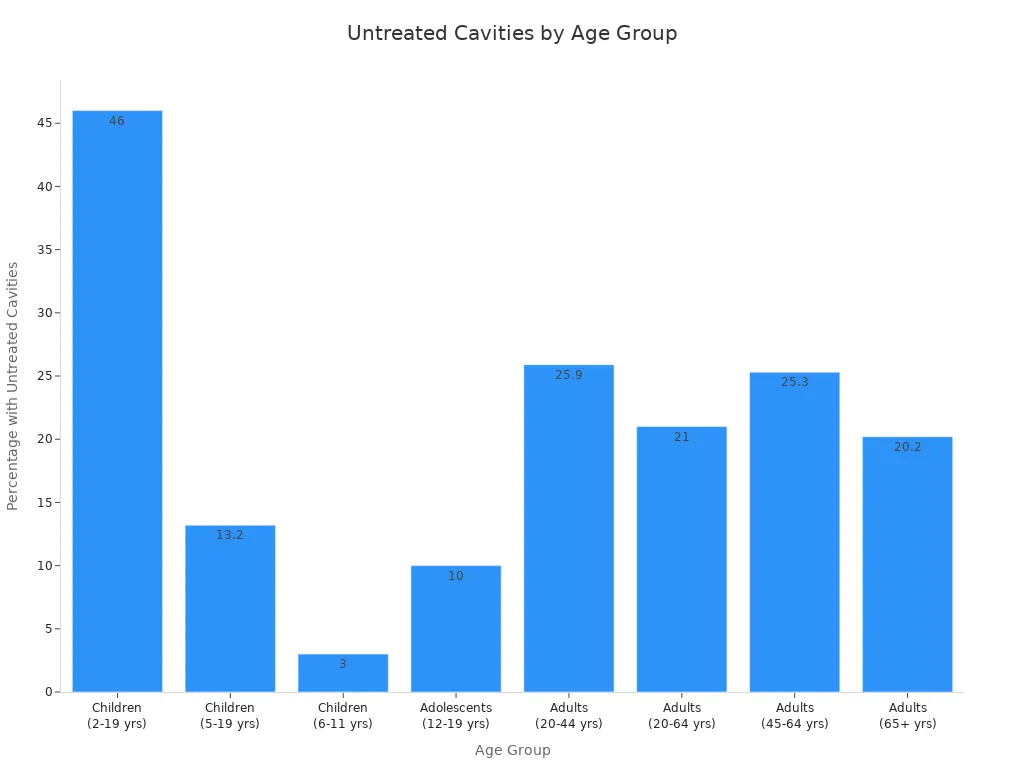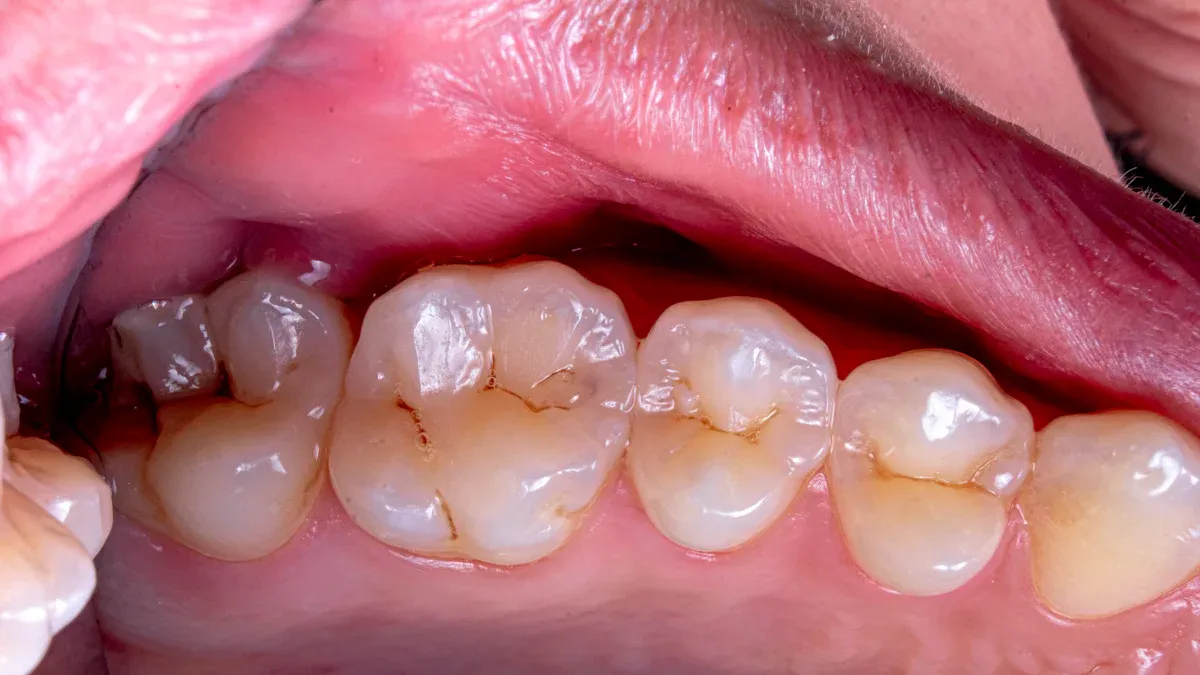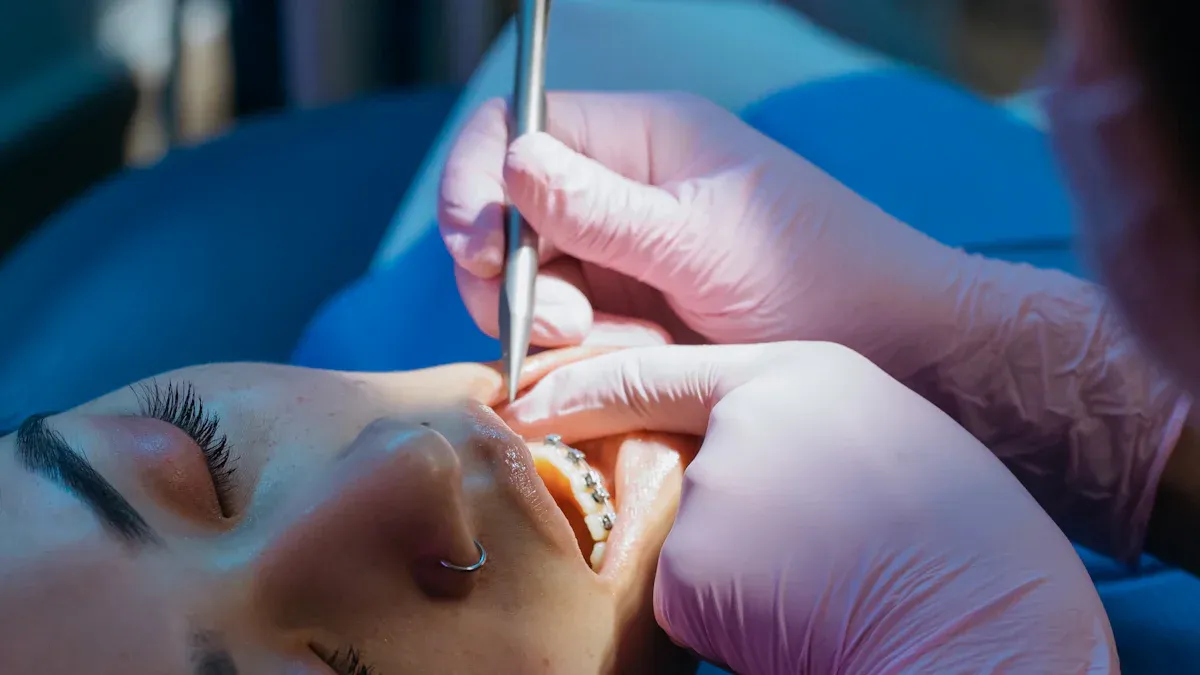- All
- Product Name
- Product Keyword
- Product Model
- Product Summary
- Product Description
- Multi Field Search
Views: 0 Author: Site Editor Publish Time: 2025-08-29 Origin: Site









Many people get cavities each year. You might see signs of a cavity like toothache, sensitivity, a change in tooth color, or even holes you can see in your teeth. Other signs are pain when eating sweets or feeling rough spots on your teeth. Tooth decay often starts small, so look for dark spots or holes in your teeth. Here is how cavities affect different age groups:
Age Group | Percentage with Untreated Cavities |
|---|---|
Children (6–11 years) | 3% |
Adolescents (12–19 years) | 10% |
Adults (20–64 years) | 21% |
Adults (65 and older) | 20.2% |

You may wonder how to know if you have cavities. Some signs are easy to see at home, but dental equipment provides the best answer. Finding cavities early helps save your teeth and stops bigger problems. So, regular dentist visits are important for a healthy mouth.
Watch for signs like tooth pain, sensitivity, or spots. Finding cavities early stops bigger issues. Check your teeth at home by looking and feeling for rough spots. Use a dental mirror to see hard places. Go to your dentist often for checkups. Dentists use tools like x-rays and lasers to find hidden cavities. Act fast if you have a toothache or sensitivity that will not go away. Treating cavities early saves pain and money. Keep your mouth clean by brushing twice a day with fluoride toothpaste and flossing every day. Seeing your dentist often keeps your smile healthy.

You might feel tooth pain if you have a cavity. The pain can be sharp or throbbing. Many dental groups say pain is a common sign of cavities.
Tooth pain is mostly caused by dental caries. Dental caries is the main reason for toothaches.
Dental caries affects many people, especially kids in school.
Toothaches can also come from gum problems, nerve pain, infection, or injury.
If you feel pain when you bite or eat sweets, pay attention. Tooth decay can make your teeth hurt even when you are not eating.
Sensitivity is another sign you might have a cavity. You may feel a quick, sharp pain with hot, cold, sweet, or sour foods. This pain can start suddenly and stop fast.
Tip: If one tooth feels more sensitive than others, look for other signs of tooth decay.
Here is a table that shows the types of pain from cavities and sensitivity:
Type of Pain | Description |
|---|---|
Cavity Pain | Ongoing toothache or sharp pain, often happens with hot, cold, or sweet foods. |
Tooth Sensitivity Pain | Quick, sharp nerve pain from hot, cold, sweet, or sour foods. |
Sometimes you can see signs of cavities on your teeth. Look for dark spots, holes, or color changes. Dental groups say visible spots or dark areas are common symptoms.
But studies show color alone is not always a good sign.
Opacity or color change after air drying can mean demineralization.
Active root lesions look yellow or light brown.
Arrested lesions are dark, but color does not always show if a cavity is active.
If you see changes in your teeth, visit a dentist. Going to the dentist often helps find tooth decay early.
You may wonder how to tell if you have cavities before visiting a dentist. While only a dental professional can confirm tooth decay, you can use several self-check methods at home to spot early signs. These steps help you check if you have cavities and know when to seek help.
Start with a visual inspection. Stand in front of a mirror with good lighting. Open your mouth wide and look closely at your teeth. Try to see a cavity by searching for dark spots, holes, or changes in color. If you notice any rough or chalky areas, these could be early signs of tooth decay. You may also see a cavity in your mouth as a small pit or shadow.
Use a clean finger or a soft dental tool to gently feel your teeth. Run your finger over the surface to check for roughness or pits. If you feel a sticky or uneven spot, this may help you identify a cavity. Always be gentle to avoid hurting your gums.
Pay attention to sensitivity to temperature. If you feel pain or discomfort when eating or drinking something hot or cold, this could be a sign of a cavity. Sensitivity to hot and cold often means the enamel is weak. This test can help you see a cavity that is not visible.
A small dental mirror can help you check hard-to-see areas. Hold the mirror to look behind your teeth and along the gumline. Try to see a cavity by looking for dark spots or holes. This tool makes it easier to check if you have cavities in places you cannot see with a regular mirror.
Sometimes, other problems can look like cavities. Gum irritation, food stuck between teeth, or even a chipped tooth can cause pain or sensitivity. If you see a cavity but the pain goes away quickly, it might not be tooth decay. Always check for more than one sign before you decide.
Tip: Use the table below to compare common at-home tests for how to see a cavity.
Test Name | Purpose | Method Description | Response Description |
|---|---|---|---|
Cold Test | Evaluate the response of the pulp to cold stimulus | Apply ice or refrigerant spray to the tooth | Healthy tooth responds with a brief, sharp sensation; prolonged response may indicate damage. |
Heat Test | Check the pulp’s reaction to heat | Apply a heated instrument or warm water to the tooth | Healthy tooth should have a brief sensation; altered response may signify a problem. |
Percussion Test | Identify inflammation in surrounding tissues | Gently tap the tooth with an instrument | Pain or tenderness may signal inflammation or infection related to pulp health. |
Palpation Test | Detect tenderness or swelling in supporting tissues | Press the gums and surrounding tissue with fingers | Sensitivity may indicate an issue connected to the tooth’s vitality. |
At-home checks can help you see a cavity, but they have limits. You may miss early signs of tooth decay, especially between teeth. Symptoms of cavities can look like other dental problems, making it hard to identify a cavity on your own. Self-diagnosis may cause you to underestimate the problem, which can lead to deeper tooth decay or even nerve damage. Relying only on home checks can let cavities grow without obvious signs. You may need more serious treatment, like a root canal, if you wait too long.
Note: Professional dental exams use special tools and X-rays to see a cavity that you cannot find at home. Always visit your dentist if you suspect a cavity in your mouth.

Modern dental equipment helps dentists find a cavity fast. Dentists use special tools to check your teeth for tooth decay. These tools can find problems you might not see at home. FOSHAN KEJU MEDICAL APPARATUS CO.,LTD is a top maker of dental equipment. The company makes many products, like dental units, air compressors, and diagnostic tools. Their products have ISO13485 and CE certifications. This means you can trust their quality and safety.
A small mouth mirror is a key tool for dentists. Dentists use it to look at the back of your teeth. It helps them see places that are hard to check. The small mouth mirror lets dentists spot dark spots or holes. They can also see color changes that may mean a cavity. Dental books say dental mirrors are important for finding cavities early. Dentists use them to look for tooth decay in places you cannot see. Finding cavities early with a small mouth mirror helps you get care before it gets worse.
Dental Equipment | Description |
|---|---|
Dental Explorer | A sharp hook used to detect defects on tooth surfaces and assess plaque or tartar presence. |
Mouth Mirror | A small mirror that helps dentists see hard-to-reach areas and improves visibility. |
Sickle Probe | Also known as a dental explorer, it detects cavities and assesses periodontal disease. |
Tip: Dentists often use a small mouth mirror with other tools. This helps them find all signs of tooth decay.
Explorers and probes are sharp, thin tools for checking teeth. Dentists use them to feel for sticky spots or rough areas. These signs can mean you have a cavity or early tooth decay. The explorer can also check for pulp exposure. This is important for finding deeper cavities. Dentists use these tools to look for enamel and dentin problems.
A dental explorer checks for rough spots and decay.
The explorer can find pulp exposure to help spot cavities.
Dentists use explorers to look for enamel and dentin problems.
These tools help your dentist know how bad the cavity is. They also help decide what treatment you need.
Dental x-rays are important for finding cavities. X-rays let your dentist see inside and between your teeth. Cavities often hide in these places. Dental x-rays can show tooth decay that you cannot see in a regular exam. Dentists use x-rays to check for cavities between teeth and under fillings.
Laser tools, like DIAGNOdent and CariVu, are new ways to find cavities early. DIAGNOdent uses a laser to check tooth hardness. If it finds soft spots, there may be decay. Studies show DIAGNOdent finds about 71% of cavities and is right about 84% of the time. This means it can find most cavities early, even before x-rays do. CariVu uses near-infrared light to find cavities without radiation. It gives clear pictures of hidden decay and is safe for kids.
Feature | CariVu | Traditional X-rays |
|---|---|---|
Detection Capability | Detects cavities at earliest stages | May miss early-stage cavities |
Visualization | Provides clearer images in hard-to-see areas | Limited visibility in certain areas |
Radiation Exposure | No radiation exposure | Involves radiation exposure |
Invasiveness | Non-invasive, no discomfort | May require invasive procedures |
Treatment Options | Allows for conservative treatment | May lead to more invasive treatments later |
Note: Laser tools and dental x-rays work best together. Your dentist can find a cavity early and plan the right care.
Professional dental equipment works better than home checks. Laser cavity detection is right over 90% of the time. Old methods can miss up to half of cavities. AI-powered dental x-rays help dentists find early tooth decay with high accuracy. Early detection means you can get easier treatment and keep your teeth.
Method | Accuracy Rate |
|---|---|
Laser Cavity Detection | >90% |
Traditional Methods | Up to 50% missed |
Dentists follow steps to check for cavities:
Step | Description |
|---|---|
1 | Find out your risk level |
2 | Look for risk factors and check for cavities |
3 | Make a plan for your care |
4 | Do the needed treatments |
Dentists also sort cavities by stage:
Caries Classification | Description |
|---|---|
Sound | No evidence of caries |
Initial | Early stage of caries |
Moderate | More advanced caries |
Extensive | Severe caries needing care |
FOSHAN KEJU MEDICAL APPARATUS CO.,LTD (FSKEJU) is a leader in dental equipment. Their products, like dental units, air compressors, lights, and diagnostic tools, help dentists find cavities with great accuracy. FSKEJU products have ISO13485 and CE certifications. This shows they care about quality and safety. Dentists around the world trust FSKEJU for tools that make finding cavities easier and more accurate.
Ready to upgrade your dental practice? Contact FSKEJU for advanced dental equipment solutions!
Go to the dentist if you see changes in your mouth that stay. Some signs mean you need help fast to keep your teeth safe. You want to stop damage to your enamel. Watch for these warning signs:
Tooth sensitivity with hot or cold foods
Toothache that will not go away
Holes or pits you can see in your teeth
Bad breath that stays after brushing
Swollen or bleeding gums
Teeth that feel loose or wiggle
Pain when you chew food
White spots on your teeth
Sores or lumps in your mouth
Jaw pain or clicking sounds
Dry mouth
If you have any of these symptoms, make a dentist appointment. Dental hygienists and dentists can check for tooth decay. They will help you learn how to treat a cavity before it gets worse.
Tip: Acting early can stop a small cavity from becoming a bigger problem.
Getting a cavity treated early can save you pain and money. Cavities begin with demineralization. This shows up as white spots on your teeth. If you wait, tooth decay can get deeper and cause more harm. Here is what happens if you do not treat cavities:
Demineralization starts in the first few months.
Enamel decay can happen in six months to one year.
Dentin decay may show up after one or two years. This causes more pain.
Pulp damage and infection can happen after two years. This leads to severe pain.
Tooth loss and other health problems may come if you do not get treatment.
Early treatment has many good effects. You can stop more decay, save money, and avoid pain. You also have a better chance to keep your natural teeth longer. The table below explains why early visits are important:
Evidence Summary | Findings |
|---|---|
Cavity Prevention Approach | Early care lowers dental decay and saves on treatment costs. |
CAMBRA Method | Preventive care can stop or reverse tooth decay. |
Early Preventive Dental Visits | Early visits mean fewer dental procedures for kids. |
Seeing your dentist quickly helps you avoid lasting damage to your enamel. Dentists use special tools to find cavities early. They will explain how to treat a cavity. Fast action keeps your smile healthy and strong.
Spotting cavity signs early helps you keep your teeth safe. Dentists use special dental equipment to find cavities well. If you see any warning signs, act fast. You can keep your mouth healthy by doing these things:
Brush your teeth two times a day with fluoride toothpaste. Floss every day.
Go to your dentist often for cleanings and checkups.
Ask your dentist about fluoride treatments and dental sealants for more protection.
Taking care of your teeth early keeps your smile healthy and stops problems later.
You get a cavity when bacteria in your mouth make acids that break down your tooth enamel. Eating sugary foods and not brushing well can speed up this process.
You cannot reverse cavities at home once a hole forms. You can stop early tooth decay by brushing with fluoride toothpaste and eating less sugar. Visit your dentist for treatment.
Dentists use special tools like dental mirrors, explorers, and x-rays. These tools help them find cavities hidden between teeth or under the surface.
Cavities do not always cause pain. Sometimes you will not feel anything until the cavity gets bigger. Regular dental checkups help catch problems early.
You should check your teeth every day when you brush. Visit your dentist every six months for a full exam. Early checks help you find a cavity before it gets worse.